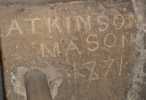For this church:    |
Nottingham St MaryInscribed MarksDeering the historian wrote: Before I leave the chancel I must take notice of an old piece of painting upon the wall over the vestry door, almost effaced, which I have often attentively look’d upon: Of this what is left, and may be discover’d without the help of a strong imagination, is the figure of a man of a gigantic size, with his right arm bent upwards and the hand inwards, the left arm and shoulder is in part worn out but the hand is so placed in the side, that without doubt it had been a kembo; his face seems to be looking towards his right side, his legs standing in water, to denote which the plainer (for it was certainly done by a very different hand) a fish is painted swimming between them; on his left at a distance are still to be seen a few houses, and in the water there seems to appear two heads of ships. The table of the Kings Arms is fixed over the middle of the body and covers part of the legs. On the right hand there is the figure of a Fryar looking and holding up something like a book in his left hand. On the third pier from the west on the south side of the nave can be seen the faint traces of an eighteenth century inscription:
and on the fifth pier from the west on the same side are three small engraved crosses. On the door frame of the Chantry door on the north aisle is a similar cross to the one mentioned above, also a flower with three petals on a curved stem, a three legged cross and the letter W. These are masons’ marks which are numerous throughout the church. Within the tower are several graffiti marks CMS 1660, T Birch 1765, and Atkinson Mason 1871 and T. Perry Mason 1871 with his mason’s mark. On the north chancel parapet is I.Crosboult 1789, on the south parapet of the nave is T. Green 1895; on the south side of the chancel on a lead panel fixed to the lead roof is M. Broomhead & Sons Bakewell 1939. Outside, on the north buttress of the east end of the church, facing east is a scratch dial. On the same stone facing north is engraved:
On the south east corner of the Lady Chapel, built in 1912-1913 by Temple Moore, is the Foundation Stone with the Latin inscription which translates as:
At the apex of the west end of the nave roof is a stone cross. Behind and below the cross is a stone with the inscription carved into it:
Many of the lead drainage headers bear dates from 1790. The newel stairs up to the tower has the date 1811, with a date of 1818 on the south transept.
| ||||||||||||









